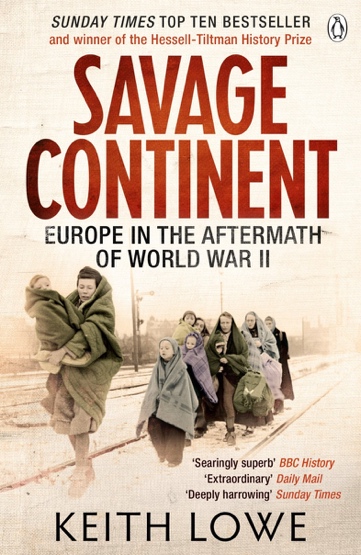Savage Continent is a deeply harrowing account of Europe as a continent reeling from the impacts and consequences of World War II. In a moving, measured and provocative narrative, he describes a place given over to mourning, hate, violence and despair. The Germans forced far-reaching changes on occupied countries that would take years to recover from. The Allies were underprepared for the scale of humanitarian actions that would be required when places were liberated. Animosities suppressed during the war and created during the war erupted in vengeful violence. The scale and complexity of the issues and challenges are difficult to comprehend.

Lowe paints this picture in four parts: the legacy of war, which assesses the physical destruction, displacement, famine, chaos and moral decay; vengeance, which examines several cases of violence; ethnic cleansing, which examines several case-studies of forced emigration; and civil war, which examines some of the numerous conflicts that existed both during and after the war. Lowe focuses on the years immediately following Germany’s surrender in May 1945, roughly down to the imposition of Stalinist tyranny on Eastern Europe and before the implementation of the Marshall Plan.
The defeat of Nazi Germany was cause for gratitude and even elation, but achieving that defeat left virtually all of Europe so devastated that “it is difficult to convey … the scale of the wreckage caused by the Second World War,” wreckage not merely physical but psychological and moral as well.
The war tore a huge hole in the demographics of the Continent, so that there were far more women than men, and a million orphans in both Germany and Poland. The sense of loss was both personal and communal. Just as the continent’s towns and cities had been replaced by a landscape of crumbling ruins, so too had families and communities been replaced by a series of gaping holes.
People were degraded to the point where their sole concern was their next meal, for which young and old were prepared to do anything amid a more pervasive moral collapse. The journalist Alan Moorehead, in Naples immediately after its liberation, witnessed “the whole list of sordid human vices” and wrote: “What we were witnessing in fact was the moral collapse of a people”.
The violence continued long after peace had been declared. Hidden behind the big conflict between the Allies and the Axis were “dozens of other, more local wars, which had different flavours and different motivations in each country and each region. In some cases, they were conflicts over class or other political differences. In other cases … they were conflicts over race or nationalism.”
Men used to extreme violence were hard to ‘switch off’. A British officer watched a Red Army soldier stab an old German man to steal his watch and chain. After he handed the Russian over to Soviet commanders, they glanced at the evidence. “You say this man killed a German?” They smiled, before kissing the culprit, pinning a red star on his tunic and sending him off.
Violence and vengeance figure prominently in Lowe’s account, much of it directed at Germans and those who collaborated with them. Liberated concentration and slave labour camp inmates tore their guards to pieces, sometimes with the connivance of Allied soldiers. German civilians were also routinely abused by newly liberated populations, often before they were forcibly expelled to remove a minority presence the Nazis had exploited to justify invasion.
Germans as victims recur many times. Lowe mostly avoids the fashionably relativist approach in which Germans are as much sinned against as sinning. Lowe rightly points to the rigours of the mass expulsions which ethnic Germans and other minorities underwent. But he does not dwell on the complicity of many of these ethnic Germans in the occupying regimes which their metropolitan fellow countrymen established to realise a collective racial fantasy that was not just of Hitler’s devising.
Lowe includes one brief chapter on Hope early in the book to counter-balance the overwhelming negatives. There were many good news stories – for example, in the efforts of organisations such as the United Nations Relief and Rehabilitation Administration and the demise of several dictatorships.
Keith Lowe is an authority on the Second World War and author of the critically acclaimed Inferno: The Devastation of Hamburg, 1943. He has spoken often on television and radio, both in Britain and the United States.
Savage Continent contains 29 black and white photographs, 12 good quality maps, a significant list of sources, notes and a comprehensive index. It is a Sunday Times top ten bestseller and was awarded the Hessell-Tiltman History Prize. I highly recommend it to all those who have an interest in war and society.
Contact Marcus Fielding about this article.






